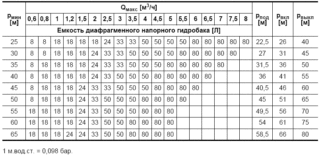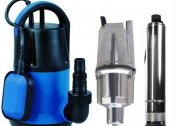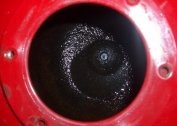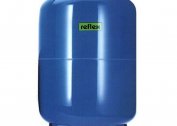There are 2 media inside the tank: air (gas) and water, which fills the rubberized membrane. When the pump turns on, the water enters a special tank. In this case, the gas is compressed and its pressure increases. Because of this, under pressure, water escapes from the membrane into pipes. When the pressure reaches the required value, the pump automatically stops its operation and turns off. Water begins to be pushed out of the accumulator. If the liquid in the tank decreases, then the pump turns on again and everything happens in a new circle.
Normal pressure values in the accumulator are necessary in order to create favorable conditions for the pump. It is the gas pressure that makes it impossible to turn the device on and off after each opening of the tap. In addition, optimal pressure contributes to:
- Prevent water hammer that can destroy pipes and mixers.
- Increase pump life.
- Creating a reserve stock of water in the tank. It is used for power outages.
Types of accumulators
 There are several varieties of water tanks:
There are several varieties of water tanks:
- One that is only responsible for cold water. It is necessary in order to save and serve unheated water. In addition, this battery helps to avoid water hammer, due to a sharp change in pressure, in various household electrical appliances: washing machine, dishwasher and others. If you use this tank less often, then it can last a very long time. Usually has a blue color. It can be made in both horizontal and vertical versions.
- Responsible for hot water. Heats and delivers heated water. Works flawlessly at high temperatures. It has a red color. It can be made in vertical or horizontal version.
- Heating. They are installed in the design of closed heating systems. The pump turns on when the pressure changes and drives hot water through the pipes. This accumulator is also called expansion.
In addition, tanks can vary in volume. In the Russian market, specimens from 20 liters and up to 1000 liters are sold. But, basically you can find hydraulic accumulators in volume:
- 24 l
- 50 l
- 60 l
- 80 l
- 100 l
The most popular of the presented models are tanks of 80 and 100 liters. They are perfect for medium families.
Optimal performance
 In addition to the capacity, the pressure indicator in an empty tank is very important. Usually, the normal indicator is indicated by the manufacturer on the accumulator housing itself. It is not difficult to calculate the optimal performance in the entire network. This is determined by the hydrostatic pressure, which depends on the height to which water must be raised. Thus, the normal pressure in the network with a pipe height of 5 meters will be 0.5 bar; 20 meters - 2 bars. A deviation of up to 1 bar is possible, this is considered the norm. It should be borne in mind that the operating pressure of the accumulator must not exceed the pump. Most often, tank manufacturers set the air supply at 1.5 bar to their units. However, as practice shows, the data may vary. It is better to check the pressure with a pressure gauge before using the accumulator. If you follow the recommendations, you can save a considerable amount of fluid until the next start of the pump.
In addition to the capacity, the pressure indicator in an empty tank is very important. Usually, the normal indicator is indicated by the manufacturer on the accumulator housing itself. It is not difficult to calculate the optimal performance in the entire network. This is determined by the hydrostatic pressure, which depends on the height to which water must be raised. Thus, the normal pressure in the network with a pipe height of 5 meters will be 0.5 bar; 20 meters - 2 bars. A deviation of up to 1 bar is possible, this is considered the norm. It should be borne in mind that the operating pressure of the accumulator must not exceed the pump. Most often, tank manufacturers set the air supply at 1.5 bar to their units. However, as practice shows, the data may vary. It is better to check the pressure with a pressure gauge before using the accumulator. If you follow the recommendations, you can save a considerable amount of fluid until the next start of the pump.
Verification Methods
 The air that was pumped by the manufacturer into the tank gradually escapes through the rubber membrane. The rarefaction of the cavity with gas leads to a strong stretching of the “pear” while it is filled with water.Without proper resistance, the membrane quickly loses its properties and can burst or break. Pressure measurements are measured by a special device - a manometer. It is better to use the automotive version, as it will show the most accurate results.
The air that was pumped by the manufacturer into the tank gradually escapes through the rubber membrane. The rarefaction of the cavity with gas leads to a strong stretching of the “pear” while it is filled with water.Without proper resistance, the membrane quickly loses its properties and can burst or break. Pressure measurements are measured by a special device - a manometer. It is better to use the automotive version, as it will show the most accurate results.
Typically, the manufacturer indicates in the documentation the number of pressure accumulator checks per year. On average, measurements should be taken at least 2 times in 12 months. Before starting, it is necessary to completely empty the tank from water, and disconnect the pump from the power supply. When the system is connected to electricity, you should carefully monitor the situation. The operating pressure must be indicated on the battery certificate.
To check the tank, you need to unscrew the decorative cap that closes the nipple. You need to connect a car pressure gauge to the spool. The measuring device should have a minimum error. Cheap plastic pressure gauges will not work, as they will show completely different data. After measurement, the result should be compared with the passport, if it turns out to be less, then the tank should be pumped up using a compressor. Leave the hydraulic accumulator for a day. Next, the control size is made, if the pressure is normal, then you can assemble the system back. If the pressure is exceeded, then the air is slightly bleed.
If the battery is used in a summer residence, it must be checked before the start of the season. For any deviations from the norm, you need to make unscheduled measurements.
How to properly adjust the pressure in the accumulator
 In order for the pump unit to work stably, you need to configure it correctly. There are 3 main parameters:
In order for the pump unit to work stably, you need to configure it correctly. There are 3 main parameters:
- Pressure level after which the pump starts pumping water.
- The threshold for shutting down the installation.
- Air pressure in the tank.
Parameters 1 and 2 are regulated by a pressure switch. A special device is installed on the input plug of the battery. Adjustment takes place empirically, to reduce the error, repeat the steps several times. The design of the relay includes 2 springs. They are mounted on vertical rods and bolted with nuts. The springs differ in size and functionality: a large one is responsible for adjusting the on and off of the pump, and a smaller spring regulates the difference between the upper and lower pressures. The springs are connected to a special membrane, which closes and, accordingly, opens the electrical contacts.
Adjustment is made using a key. The desired nut must be turned clockwise. This leads to compression of the spring and an increase in the threshold for switching on the pump. Turning counterclockwise loosens the spring accordingly. There is a phased adjustment scheme:
- First you need to check the air pressure in the battery, pump up the compressor.
- Next, the nut turns over the larger spring to the optimum level.
- Turns the tap to drain the liquid. The pressure, of course, should fall, after which the hydraulic pump turns on. Indicators are remembered. If necessary, a series of actions is repeated anew.
- Next, a small spring is adjusted. It should be remembered that it is very sensitive to tuning, and therefore it is better to rotate it by 0.5 turns.
- The indicator is fixed with closed cranes and a working hydraulic pump. The device will show the value at which the equipment will stop working. If it is more than 2 atm., Then you need to slightly turn the small spring in the opposite direction.
- It is necessary to drain the fluid and restart the hydraulic pump. The process should be repeated until the best measurements are shown.


